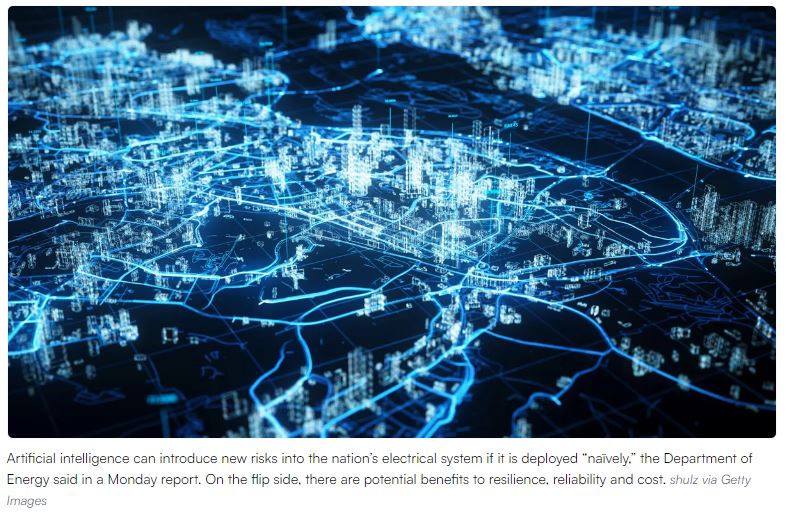Artificial intelligence can help manage the grid but creates risks if deployed ‘naïvely,’ DOE warns
- Artificial intelligence can help manage the U.S. electric grid, including reducing emissions and lowering costs — but the nascent technology poses significant risks if deployed “naïvely,” the Department of Energy said in a pair of reports published Monday.
- Priority use cases for managing the U.S. electrical system include grid planning, permitting and siting, operations and reliability, and resilience, according to the “AI for Energy: Opportunities for a Modern Grid and Clean Energy Economy” report.
- Similarly, four broad categories of grid risk have emerged, DOE said in a report titled “Potential Benefits and Risks of Artificial Intelligence for Critical Energy Infrastructure.” Those risks include adversarial attacks against AI systems, unintentional failures of AI models, the use of AI to execute cyber or physical grid attacks, and supply chain compromises.
Dive Insight:
“Artificial intelligence holds both incredible promise and potential challenges for the U.S. energy sector,” Puesh Kumar, director of DOE’s Office of Cybersecurity, Energy Security, and Emergency Response, said in a statement.
The assessments published yesterday were directed by an executive order President Biden signed in October identifying the administration’s core principles regarding the development of AI. The order also directed DOE and the Department of Homeland Security to assess AI systems’ threats to critical infrastructure.
Potential risks associated with AI include “poisoning attacks,” where an attacker could “add, modify, or alter the data used to train an artificial intelligence model, in order to force the model to learn the wrong behavior. This can include modifying data on energy system operations,” according to the CESER report.
A poisoning attack could result in an AI model misunderstanding what normal energy systems operations look like, the report said. More sophisticated attacks could alter training data “so that a model meant to detect physical wear in oil and gas equipment never declares an equipment to need maintenance.”
AI could also allow less-sophisticated adversaries to carry out cyber or physical attacks on energy infrastructure, CESER warned.
The new technology could enable “autonomous control of devices for physical attacks,” the report said. “Adversaries could combine AI-enhanced capabilities with other technologies, such as unmanned drone systems, in order to execute remote physical attacks on energy infrastructure.”
There are also risks associated with the development of AI tools, the report found. Machine learning models created with “a mismatch between training data and real-world use” can skew outcomes in energy systems, CESER said. And the use of AI to make predictions about unexpected events, such as extreme weather, “can lead to unpredictable or inaccurate behavior.”
Ultimately, CESER concluded most of the risks “can be mitigated through best practices, putting appropriate protections around important data and models, and in some cases, funding further research on mitigation techniques.”
To read the complete article, visit Utility Dive.

















